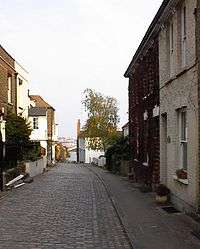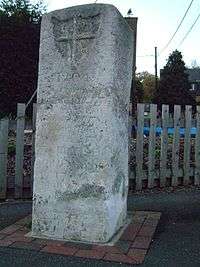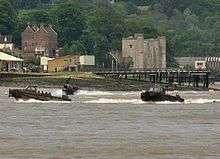Upnor
| Upnor | |
 Upper Upnor High Street |
|
 Upnor |
|
| District | Medway |
|---|---|
| Shire county | Kent |
| Region | South East |
| Country | England |
| Sovereign state | United Kingdom |
| Post town | Rochester |
| Postcode district | ME2 |
| Police | Kent |
| Fire | Kent |
| Ambulance | South East Coast |
| EU Parliament | South East England |
Coordinates: 51°24′37″N 0°31′34″E / 51.4104°N 0.526°E
Lower Upnor and Upper Upnor are two small villages in Medway, Kent, England. They are in the parish of Frindsbury Extra on the western bank of the River Medway. Today the two villages are mainly residential and a centre for small craft moored on the river, but Upnor Castle is a preserved monument, part of the river defences from the sixteenth century.
Origins
Upnor meant "at the bank" being "æt þæm ōre" in Old English and "atten ore" in Middle English and "atte Nore" in 1292. However, the meaning changed to "upon the bank" (Middle English: "uppan ore") and by 1374 it was "Upnore".[1]
A skeleton of a Straight-tusked Elephant was excavated in 1911, during the construction of the Royal Engineers' Upnor Hard.[2]
Lower Upnor

Lower Upnor faces Upnor Reach. It was a single row of houses, separated from the river by the roadway and the hard. Located here is the Arethusa training centre, run by the Shaftesbury Homes.[3] In 1849, HMS Arethusa was the name of the training ship moored near the shore. The society had moored a training ship here for over 105 years. The first was the Chichester, but after then all the ships were called Arethusa. The last but one Arethusa was the Peking, one of the R.F Laeisz's Flying P-Liner four-masted barques, built in 1911, and acquired after 1918 as war reparations. She was sold in 1975 to the South Street Seaport Museum in New York. The last Arethusa, a 23 metre two-masted ketch, was sold in 2000 and now sails with the Cirdan Sailing Trust under the name Faramir.
In recent times extra housing has been built behind this street, exploiting the land exposed by quarrying the steep hillside that leads to Hoo Common.[2]
Lower Upnor is also the home of two yacht/sailing clubs. Medway Yacht Club, which was founded in 1880,[4] purchased land in Lower Upnor in 1948, now comprising approximately 14 acres (57,000 m2). Upnor Sailing Club was formed in the 1962[5] and moved into its present Club House (formed from renovating three existing traditional riverfront cottages) in the 1980s.
Upper Upnor
Upper Upnor comprises a village cobbled high street leading down to Upnor Castle. It has many houses displaying Kentish weatherboarding, some are Grade II listed. [6][7] It also has some terraced streets formerly used by the MOD and also Castle Street. It is on Chatham Reach directly opposite St Mary's Creek.[2]
London Stones

The London Stones are in Lower Upnor on the shoreline. They mark the limit of the charter rights of London fishermen. The older stone is dated 1204.
Industry
Like other parts of Frindsbury, chalk has been extracted, high quality moulding sand has been taken from a pit near the Church, and William Burgess Little built 25 five barges at his yard between 1843 and 1871. The first was the Sarah Little and the last called W.B.Little Finish. James Little built three barges here in 1891, 1893, and 1895.[8] A potter's kiln can be seen on an 1830 watercolour by Susan Twopeny, now in Rochester Guildhall Museum.
The Church
The ecclesiastical parish of Upnor split from Frindsbury in 1884 and was reabsorbed in 1955. The parish church of St Philip and St James (1884) was designed by Ewan Christian. It is virtually unaltered.[8] Francis Drake's father, was ordained deacon and made vicar of the Church upon the River Medway.[9]
The Military
Upnor Castle
Upnor Castle was built as an artillery fort between 1559 and 1567 in order to protect Chatham Dockyard and the associated naval anchorage. It was called into action in June 1667 when the Dutch Navy conducted a raid on the ships moored in the river; the castle proved ineffective in repelling the attack and it was decommissioned soon afterwards. Though the castle was only operational as a fort for about 100 years, it was retained as a magazine and ammunition store until the end of the First World War; continuing in military use through World War II, it was opened to the public as a museum in 1945.[10]
Lower Upnor Ordnance Depot

Upnor Castle castle served as a gunpowder magazine for the Board of Ordnance from 1668, providing powder for the defences of Chatham Dockyard and for the fleet based in the Nore. In 1810 a new magazine with space for 10,000 barrels of gunpowder was built downriver from the castle (which had long needed to expand its capacity) along with a 'shifting house' for inspecting powder that had arrived by sea.[11] In 1856 a second magazine was constructed alongside and to the same design (though with more than double the capacity); this still stands on the river bank, the earlier magazine and shifting house having been demolished in 1964. At the same time, buildings began to be constructed for storing artillery shells and the site began to be extended to the north. There was not enough space, however, for further bulk storage of gunpowder, so a set of five magazines were built inland instead, at Chattenden (which was linked to Upnor by a narrow-gauge railway – see below).[12]
In 1891 Britain's Ordnance Yards were split between the Admiralty and the War Department, Upnor going to the former, Chattenden to the latter.[13] The Admiralty therefore embarked on building a new inland depot, next to Chattenden, at Lodge Hill; opening in 1898, it dealt principally with cordite. At Upnor itself further Shell Stores was built in the 1880s, supplemented by new buildings for storing wet and dry guncotton (used in torpedoes and mines) in the 1895. These sites, which became known as Chattenden and Lodge Hill Military Camps, were put up for sale in 2016.[14]
The Military Railway
The army used this area to train a railway engineering force. They built a standard gauge railway from Chattenden to Upnor in 1872–73. This was abandoned before 1881 and a 2 ft 6 in (762 mm) gauge line was built in 1885[8] or by the 8th (Railway) Company R.E. in 1898.[15] One branch went to Lower Upnor, and the other to the camp by Tower Hill. This line was used to supply armaments from Chattenden, the Lodge Hill Ammunition Depot and the standard gauge at Sharnal Street, to the warships and the Upnor Magazine. The service closed on 19 May 1961.
In 1965–1967, the Royal Engineers converted the route from Lower Upnor to Chattenden into a road, including building a new bridge over Four Elms Hill (the main road through Chattenden village). The new road is named Upchat Road.
The Royal Engineers

The Royal Engineers still have a presence in Upper Upnor; the Royal School of Military Engineering (Riverine Operations section) maintains classrooms, workshops and a hard in Upnor for the training of Royal Engineers Assault Boat Operators and Watermanship Safety Officers, who continue to operate craft on operations all over the world. The section operates Mk 1 and 3 Rigid Raiders, and Combat Support Boats, as well as teaching use of the Mk 6 Assault Boat. The area is also used for other training purposes by the RSME including practice and test Bomb Disposal tasks by the Defence EOD School, until its move to Bicester.
See also
References
- ↑ Glover, Judith (1976). The Place Names of Kent. Meresborough Books. ISBN 0-905270-61-4.
- 1 2 3 Matthews M.A., Brian (1971). A History of Strood Rural District. Strood Rural District Council.
- ↑ Hughes, Rebecca (29 May 2013). "Figurehead of the war ship Arethusa in Lower Upnor has been restored after a wasp attack". kentonline.co.uk. Retrieved 8 April 2014.
- ↑ Roger Revell Yacht and Rowing Club Buttons, p. 43, at Google Books
- ↑ "Upnor Sailing club". Retrieved 8 April 2014.
- ↑ "12–18, High Street, Frindsbury Extra". www.britishlistedbuildings.co.uk. Retrieved 27 February 2013.
- ↑ "30–32, High Street, Frindsbury Extra". www.britishlistedbuildings.co.uk. Retrieved 27 February 2013.
- 1 2 3 Barnard, Derek (1994). Merrily to Frendsbury-A History of the Parish of Frindsbury. Private Pub. City of Rochester Society.
- ↑ Southey, Robert. (1897). English Seamen — Howard Clifford Hawkins Drake Cavendish, Methuen and Co. 36 Essex Street WC London
- ↑ "Scheduled Ancient Monument description". Historic England. Retrieved 3 September 2016.
- ↑ "Listed structure description". Historic England. Retrieved 2 September 2016.
- ↑ "Upnor Conservation Area Appraisal 2004" (PDF). Medway council. Retrieved 2 September 2016.
- ↑ Lake, Jeremy. "Thematic Survey of the Ordnance Yards and Magazine Depots" (PDF). Historic England. English Heritage. Retrieved 2 September 2016.
- ↑ "MoD to sell Lodge Hill near Chattenden". Kent Business. Retrieved 3 September 2016.
- ↑ Saunders MA FSA FRHist, A.D. (1967). Upnor Castle Kent. English Heritage. ISBN 1-85074-039-9.
External links
| Wikimedia Commons has media related to Upnor. |
- Information about the castle
- The castle as part the Chatham defences
- The History of Shaftesbury Homes and the Arethusa, giving details of the purchase of the Pekin
- The New Museum, who bought the Arethusa in 1975, and restored her.
- More images of both London Stones
- Frindsbury Extra Parish Council